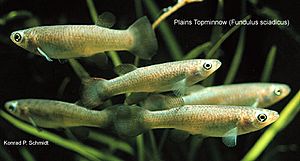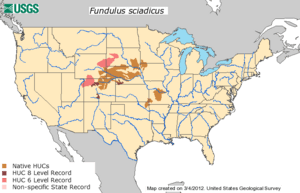Plains topminnow facts for kids
Quick facts for kids Plains topminnow |
|
|---|---|
 |
|
| Conservation status | |
| Scientific classification | |
| Synonyms | |
|
The plains topminnow (Fundulus sciadicus) is a type of small freshwater fish. It's a kind of topminnow found in North America. This fish lives in a small area within the United States. It has two main groups of populations.
Contents
What Does the Plains Topminnow Look Like?
The plains topminnow is a small fish. It is almost always shorter than 2.5 inches (6.35 cm). This fish has a flat head and a mouth that points upwards. It does not have many special markings.
Male plains topminnows have shiny fins with red tips and blue-purple stripes. They also have a gold stripe on their body. Both male and female fish are usually olive-brown. Their bellies are white. The plains topminnow also has bronze colors. It has faint blue-green lines on its back and sides.
Young fish, females, and males not ready to breed have clear or yellowish fins. This fish does not have black bars on its body. This helps tell it apart from the banded killifish. The banded killifish is a common fish often found in the same places.
Two other special features of the plains topminnow are its rounded tail fin. It also does not have a visible lateral line. The lateral line is a sensory organ fish use to detect movement. Males and females look very similar. But during breeding season, males get bright orange-red fin tips.
Where Do Plains Topminnows Live?
Plains topminnows have historically lived in two main areas. One group lives mostly in Nebraska. It also extends into Iowa, southwestern Minnesota, northeastern Colorado, and southern South Dakota. The second group lives in Missouri, Kansas, and south into Oklahoma.
The plains topminnow was once found in one county in Iowa and one in Kansas. But now, it is thought to be gone from both states. Recent studies support this idea.
Plains topminnows like places with slow-moving water. They are usually found in shallow, clear water. They also like areas with lots of plants. These places include calm pools and quiet areas of streams.
They can live in water that is a bit cloudy. They can also live in water with a moderate current. But they prefer the clear, calm conditions. Most studies show that plains topminnows can handle some warm water and low oxygen levels. Losing their habitat is a big worry for this fish. Plains topminnows prefer water temperatures between 5 °C and 22 °C.
Reproduction and Life Cycle
Plains topminnows lay their eggs in the same plant-filled areas where they live. During breeding season, males get red colors on their fins. Both males and females get a black border around their middle fins.
In Nebraska, male plains topminnows show breeding colors from late June to late July. However, these fish have been seen laying eggs anytime from late March to early August. This wide range of time is likely due to water temperature. So, when plains topminnows breed often depends on how far north or south they live. The breeding season for plains topminnows lasts about 60 days in Missouri and Nebraska.
Scientists have watched plains topminnows breed in aquariums. Males will compete with each other. They swim in circles and try to bite each other's back fins. Some males do this for up to 90 minutes. This behavior helps establish which males will be dominant for breeding. Males and females were seen wiggling in the algae. This was likely when they were laying eggs. Eggs were found in the algae after this behavior.
Mature plains topminnow eggs are about 1.8 to 2.0 mm wide.
Protecting the Plains Topminnow
The plains topminnow is not considered a federally threatened or endangered species. It has a "Global Heritage Status Rank" of G4. This means it is "apparently secure." However, the number of plains topminnows has been going down. This is especially true in the Platte and Republican River areas.
Currently, plains topminnows are found in only about 34% of the places they used to live. In Minnesota, they are still in all their historical locations. But there are fewer fish than before.
The main threats to the plains topminnow include:
- Pollution or changes to their habitat.
- Streams being broken up into smaller parts.
- New types of fish being introduced.
- Building dams and reservoirs.
- Sewage and farm runoff.
- Too much livestock grazing near streams.
- Pumping salty groundwater.
It is also believed that too many nutrients in the water (eutrophication) cause low oxygen. This also leads to high ammonia levels. These issues are adding to the decline of plains topminnow numbers.
To help protect plains topminnow populations, we should:
- Make sure streams have enough water flowing.
- Reduce how much water is taken from streams for irrigation.
- Create protected areas in parts of streams that flow all year.
- Manage livestock carefully around waters where plains topminnows live.
What Do Plains Topminnows Eat?
Scientists have not studied the eating habits of the plains topminnow very much. But it is believed they eat a variety of foods. Their diet may include insects, especially their larvae. They also eat snails and small crustaceans called Ostracods.
See also
 In Spanish: Fundulus sciadicus para niños
In Spanish: Fundulus sciadicus para niños



